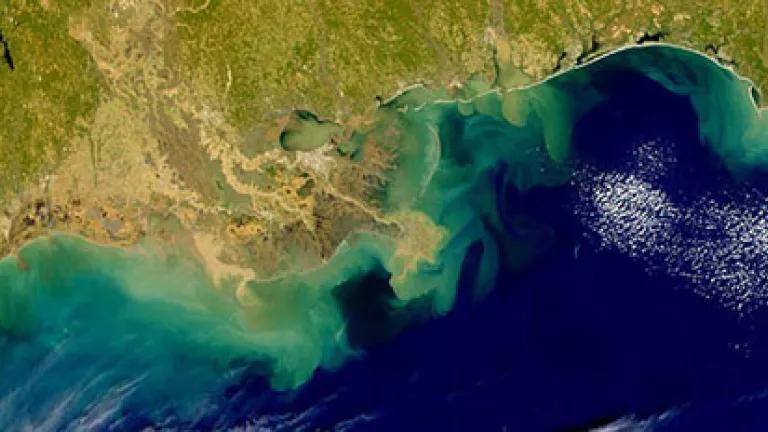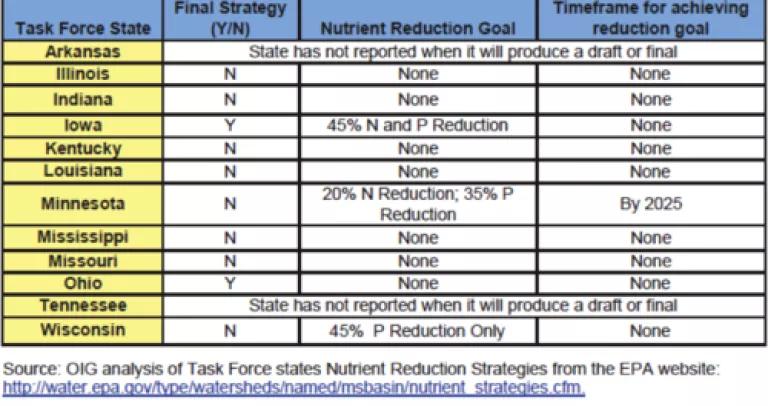EPA damns itself with faint praise in response to Inspector General's Gulf Dead Zone report

You may recall, if you follow these things, that the EPA Office of the Inspector General—EPA’s independent internal watchdog—issued a report in September criticizing EPA’s hands-off approach toward addressing the nation’s algae pollution crisis. The Inspector General provided data showing that EPA’s relentless avoidance of the problem has resulted in the vast majority of states simply punting on it as well, without measurable standards and goals, and without progress toward reducing the colossal dead zone in the Gulf of Mexico.
EPA has since responded to the September report in a remarkable exercise of damning itself with faint praise. The Agency’s pallid, nitpicking response serves only to bolster the Inspector General’s conclusion that relying on the states to solve the problem is not working; and its strong inference that the only way to get the job done is for EPA to bite the bullet and establish some hard numbers—numeric criteria, in Clean Water Act parlance—limiting algae-fueling nitrogen and phosphorus pollution. Indeed, in the one instance where EPA purports to offer a substantive factual update, it ends up providing more hard evidence supporting the need for criteria.
The Agency complains, first, about a summary paragraph in the report (p. 4, if you’re reading along) that states, “The EPA’s approach to reduce the Gulf hypoxic zone is based upon the Task Force states developing and implementing nutrient reduction strategies,” and “The EPA is assisting states in developing these strategies”—a fundamentally passive approach which, as discussed in earlier posts, has entirely failed to prompt states to take meaningful action. EPA’s beef, it would appear, is that the Inspector General did not provide a sufficiently detailed description of all the steps the Agency has taken to support and assist the states in connection with their utter failure deal with the problem. It argues that the report should have pointed out specifically that EPA is, for example, “working with states to identify and prioritize” waters that are hammered by green slime, and “providing information to the public” on these issues. Um, ok. It’s kind of as though the Inspector General has pointed out that the Titanic is going down, and EPA is concerned that he’s not sufficiently appreciative of just how spiffy they’ve made the deck chairs look.
Second, EPA complains that one of the graphics in the report depicts the Dead Zone as being 22,000 square kilometers, about the size of New Jersey, when it is currently only about 15,120 square kilometers, about the size of Connecticut. This clarification is not, shall we say, exactly reassuring about the scale of the crisis (again with the Titanic—“Well, the B deck isn’t actually going under quite as fast as you said”). The fact of the matter is, regardless of which particular east coast state the Dead Zone can be compared to in any given year (the size of the Zone changes a little from year to year based on various factors), an area of devastation the size of any state is a huge national problem that we should be pulling out all the stops to address. If there were an area on land the size of Connecticut where nothing could live, would we shrug and hope the locals would eventually do something about it? Nope, don’t think so. This is a classic situation that calls for federal action: a large-scale problem being caused by multiple states far upstream from it. And all the more so given that our Great Lakes waters are threatening to turn into algae-choked sacrifice zones as well: witness the emerging dead zone in Green Bay, and the toxic green mats taking over western Lake Erie that choked off Toledo’s water supply this past summer.
And finally, EPA complains that the Inspector General used an outdated version of a chart summarizing states’ (non-) progress toward addressing the algae problem. Well, let’s take a look. The version in the Inspector General report looks like this:

As you’ll see on the rather sadsack face of it, most states had set no goal at all for reduction of nitrogen and phosphorus (or “nutrient”) pollution, and only one of those actually set a date to achieve that goal. EPA’s updated chart is mostly a prettied up version—for example, some of the stark “none’s” have been replaced by more politely soothing variants like “not at this time,” and “to be determined through collaborative adaptive management.” But where it really gets interesting is the one place in the timeframe column where the “none” was actually replaced by a hard number. In the updated version, Wisconsin has not only established a date for meeting its 45% reduction target, but notes that it has already reduced phosphorus in its waters by an estimated 23%. Not at all coincidentally, Wisconsin is the only state in the bunch that has actually implemented numeric phosphorus criteria for its rivers and streams. (And yes, those would be the phosphorus criteria that Wisconsin’s Governor Walker has been working to roll back.)
As we, and so many others, have been saying relentlessly, numeric nutrient criteria work. They are hard limits on the levels of nutrient pollution that can exist in healthy waters, providing a benchmark for measuring the nutrient problem, and a basis for issuing permits and establishing plans to clean it up. And now, EPA—somewhat inadvertently, it seems—has supplied yet more proof of that.
NRDC and its coalition partners in the Mississippi River Collaborative are waging a thus-far successful litigation fight to compel EPA to at least take a hard look at what is and isn’t working in the states, and make a call as to whether federal action is necessary to establish numeric criteria. We recently argued EPA’s appeal of our win to the Fifth Circuit Court of Appeals (audio of the argument is here), and are now awaiting the decision. We can’t, of course, predict what the court will do. But what we can predict for near-certain is that the plague of algae besetting the country will not go away until our government replaces weak self-justification with the bold decisions necessary to start making a dent in the problem.
Photo: NASA

